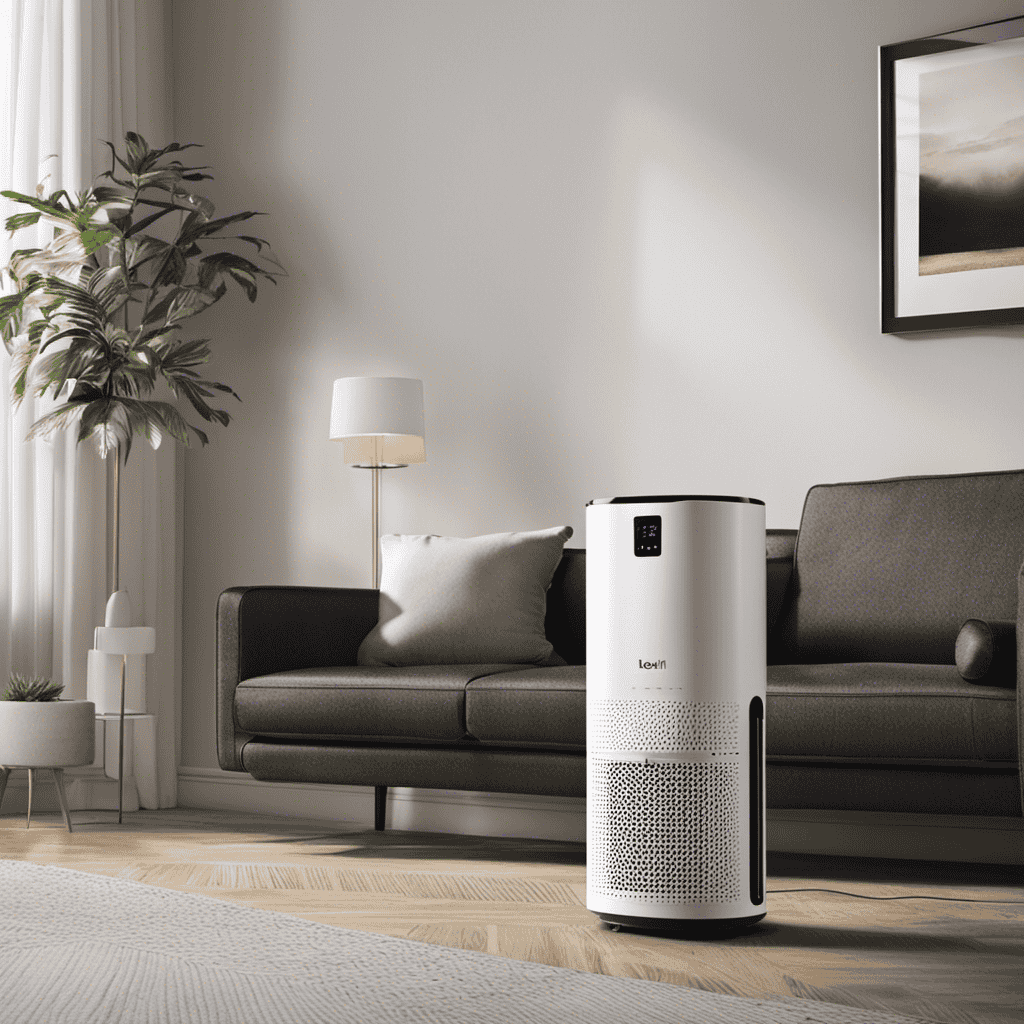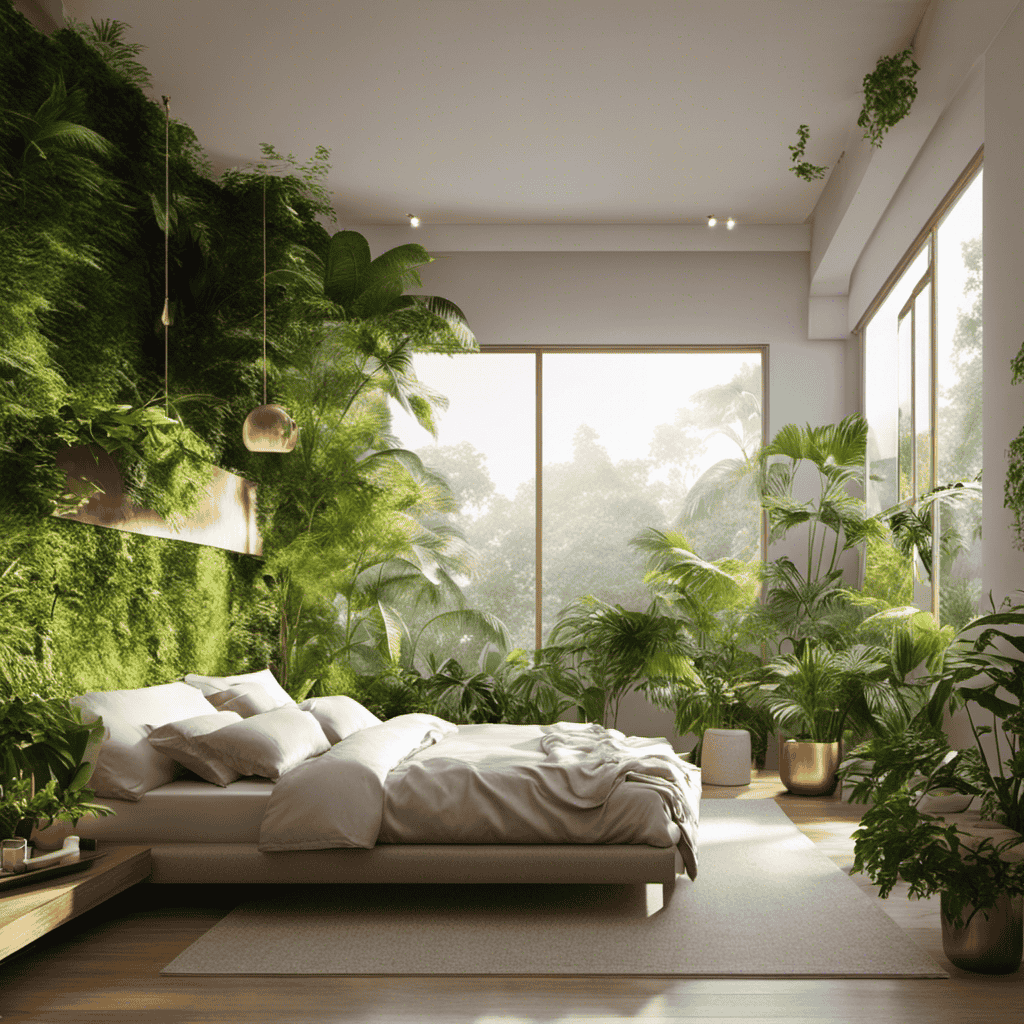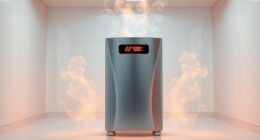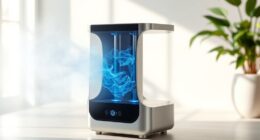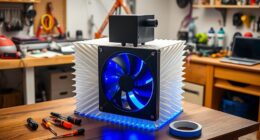As a specialist in air quality, I have researched extensively to provide you with the ultimate answer to a common question: how frequently should you change your air purifier filter?
In this article, we’ll dive deep into the factors that determine filter lifespan, explore the recommended replacement schedule, and uncover the signs that indicate it’s time for a fresh filter.
So, grab a cup of coffee, sit back, and prepare to breathe easier with our evidence-based insights on air purifier filter replacement.
Key Takeaways
- Regular filter replacement is necessary for optimal performance and to improve air quality.
- Neglecting filter replacement can lead to health issues, poor indoor air quality, and decreased efficiency of the air purifier.
- Factors such as usage patterns, air quality levels, and environmental factors affect the frequency of filter replacement.
- Investing in high-quality filters and following manufacturer’s guidelines for maintenance and replacement can ensure cost efficiency and prolong the lifespan of the air purifier.
Factors That Determine Air Purifier Filter Lifespan
You should consider factors such as air quality, usage hours, and filter type to determine how often you need to replace your air purifier filter.
Filter maintenance is crucial in ensuring the efficiency of your air purifier. Over time, dust, allergens, and other particles accumulate in the filter, reducing its effectiveness. Regularly cleaning or replacing the filter is essential to maintain clean and healthy air in your surroundings.
Another factor to consider is the filter efficiency. Different types of filters have varying lifespans and effectiveness in removing pollutants. High-efficiency filters may last longer than standard ones but may also come at a higher cost.
Understanding these factors will help you determine the optimal time to replace your air purifier filter and ensure that it continues to provide clean air for you and your family.
Understanding the Recommended Replacement Schedule
Understanding the recommended schedule for replacing an air purifier filter can help ensure optimal performance. Proper maintenance and timely filter replacement are essential to keep the air in your home clean and free from pollutants. Here are some key points to consider:
-
Regular Filter Replacement: It is generally recommended to replace the air purifier filter every 6 to 12 months, depending on usage and the manufacturer’s instructions.
-
Filter Maintenance Techniques: To extend the filter’s lifespan and maintain its efficiency, regular cleaning is crucial. Vacuuming the filter regularly and following the manufacturer’s cleaning instructions can help remove accumulated dust and debris.
-
Filter Replacement Cost: The cost of air purifier filter replacement varies depending on the brand and model. It is advisable to check the filter’s cost before purchasing the air purifier to ensure affordability.
By understanding the recommended replacement schedule and implementing proper maintenance techniques, you can maximize the lifespan of your air purifier filter and achieve the best air quality in your home.
Now, let’s explore the signs that indicate it’s time to replace the air purifier filter.
Signs That Indicate It’s Time to Replace the Air Purifier Filter
When it comes to maintaining the performance of an air purifier, understanding the filter replacement indicators and the frequency of replacement is crucial.
These key points will help ensure that the air purifier continues to effectively remove pollutants from the air.
Filter Replacement Indicators
The filter replacement indicators on air purifiers help you keep track of when to change the filter. These indicators are designed to monitor the condition of the filter and notify you when it needs to be replaced.
Here are some important points to consider regarding filter replacement indicators:
-
Automatic Monitoring: Many air purifiers are equipped with sensors that detect the level of pollutants in the air and the condition of the filter. These sensors provide accurate information about the filter’s performance and determine when it is time to replace it.
-
Visual or Digital Display: Filter replacement indicators can be displayed in different ways. Some air purifiers have a simple light that turns on when the filter needs to be changed, while others have a digital display that shows the remaining lifespan of the filter.
-
Customizable Settings: Some air purifiers allow you to adjust the sensitivity of the filter replacement indicator. This feature enables you to customize the indicator based on your specific needs and the environment you live in.
To ensure the effectiveness of your air purifier, it is essential to follow the manufacturer’s recommendations regarding the frequency of filter replacement. Additionally, regular maintenance, such as vacuuming or washing the filter, can prolong its lifespan and maintain optimal performance.
Frequency of Replacement
To ensure your air purifier is working efficiently, it’s important to follow the manufacturer’s recommendations for how often the filter needs replacing. Regular filter maintenance is crucial for maintaining clean and healthy indoor air.
The filter is responsible for capturing and trapping airborne particles, such as dust, pollen, and pet dander. Over time, these particles accumulate and can hinder the performance of the air purifier.
By adhering to the filter replacement guidelines, you can ensure that your air purifier continues to effectively remove pollutants from the air, providing a cleaner and healthier environment for you and your family.
Regular filter maintenance not only improves the air quality but also prolongs the lifespan of your air purifier.
Now, let’s explore how often you should replace a HEPA filter.
How Often Should You Replace a HEPA Filter
As an expert in air purification systems, I believe it is crucial to discuss the filter replacement frequency, the significance of clean air, and the cost of replacement filters.
Regularly replacing the filters in your air purifier is essential to maintain its efficiency and effectiveness in removing pollutants from the air.
Clean air is not only important for our respiratory health but also for reducing the risk of allergies, asthma, and other respiratory conditions.
However, it is essential to consider the cost of replacement filters as they can vary depending on the brand and type of air purifier you own.
Filter Replacement Frequency
You should check your air purifier filter regularly to determine how often you need to replace it.
The frequency of filter replacement depends on various factors, such as the type of air purifier, the quality of the filter, and the air quality in your surroundings.
Understanding the efficiency rating of your filter is crucial in determining its lifespan. Filters with higher efficiency ratings, such as HEPA filters, are designed to capture smaller particles and tend to last longer than filters with lower efficiency ratings.
Additionally, the impact on energy consumption is another aspect to consider. Filters that get clogged more quickly may restrict airflow, leading to increased energy consumption by the air purifier.
Significance of Clean Air
Breathing in clean air is essential for your overall health and well-being. The importance of indoor air quality cannot be overstated, as it directly impacts our respiratory system and overall health.
Clean air can provide numerous health benefits, such as reducing the risk of respiratory infections, allergies, and asthma attacks. Indoor air can be contaminated with various pollutants like dust, pet dander, mold spores, and volatile organic compounds (VOCs) from cleaning products and furnishings. These pollutants can lead to respiratory issues, headaches, fatigue, and other health problems.
Maintaining clean air indoors is crucial, and one effective way to achieve this is by using air purifiers with high-efficiency filters. These filters can capture and remove a significant amount of airborne pollutants, ensuring that the air you breathe is clean and healthy.
Cost of Replacement Filters
Replacing the filters in your air purifier can be costly, but it is necessary to maintain the effectiveness of the device. However, there are some cost-saving tips and alternative filter options that you can consider.
-
Clean and reuse: Some filters can be cleaned and reused multiple times, saving you money in the long run. Make sure to follow the manufacturer’s instructions for cleaning.
-
DIY filters: You can create your own air filters using materials like carbon, activated charcoal, or even coffee filters. While these may not be as effective as commercial filters, they can still help improve air quality.
-
Filter subscription services: Many companies offer filter subscription services, where you can save money by receiving regular filter replacements at a discounted price.
The Impact of Air Quality on Filter Lifespan
The quality of the air directly affects how long the filter will last. Air pollution can significantly impact the effectiveness of an air purifier filter, reducing its lifespan and compromising its ability to remove harmful particles from the air. Regular filter maintenance is crucial to ensure optimal performance and extend the filter’s lifespan. By regularly cleaning or replacing the filter, you can remove accumulated pollutants and prevent clogging, allowing the purifier to operate efficiently. Neglecting filter maintenance can lead to reduced air quality, increased energy consumption, and potential health risks. Below is a table illustrating the benefits of regular filter maintenance:
| Benefits of Regular Filter Maintenance |
|---|
| 1. Improved air quality |
| 2. Increased lifespan of the filter |
| 3. Enhanced energy efficiency |
| 4. Reduced risk of health issues |
| 5. Cost savings from prolonged use |
Taking care of your air purifier filter is essential for maintaining clean and healthy indoor air.
Different Types of Air Purifier Filters and Their Replacement Needs
When it comes to air purifier filters, understanding their lifespan and effectiveness is crucial. Different filters have varying replacement needs, and knowing when to replace them can optimize their performance.
Several factors can affect the frequency of filter replacement, such as the air quality in the environment, the size of the space being filtered, and the level of pollutants present. By considering these factors, individuals can ensure that their air purifier filters are operating at their best, providing clean and healthy air.
Filter Lifespan and Effectiveness
The lifespan and effectiveness of an air purifier filter can vary depending on factors such as usage and air quality. Proper filter maintenance is essential for prolonging the filter lifespan and ensuring optimal performance. Here are some tips to help you maximize the lifespan of your air purifier filter:
-
Regularly clean or replace the pre-filter. The pre-filter captures larger particles like dust and hair, preventing them from clogging the main filter.
-
Vacuum the filter. Gently vacuuming the filter surface removes larger particles and debris, allowing it to efficiently capture smaller pollutants.
-
Follow manufacturer’s recommendations. Check the user manual for specific instructions on filter maintenance and replacement intervals.
Factors Affecting Replacement Frequency
In order to maximize the lifespan of your air purifier filter and reduce the frequency of replacements, it is important to properly maintain the filter. Regular filter maintenance can significantly extend its lifespan, saving you time and money in the long run.
There are several factors that can affect the replacement frequency of your air purifier filter. These include the air quality in your area, the size of the room being purified, and the level of pollutants present. By understanding these factors and taking appropriate measures, you can effectively extend the lifespan of your filter.
To give you a better understanding, here is a table summarizing the key factors affecting replacement frequency and ways to extend your filter’s lifespan:
| Factors Affecting Replacement Frequency | Ways to Extend Filter Lifespan |
|---|---|
| Air quality in your area | Regularly clean pre-filters |
| Size of the room being purified | Avoid smoking indoors |
| Level of pollutants present | Keep windows and doors closed |
Tips for Extending the Lifespan of Your Air Purifier Filter
To extend the lifespan of your air purifier filter, you should regularly clean it and replace it as recommended by the manufacturer. Proper filter maintenance is crucial in ensuring that your air purifier works efficiently and effectively.
Here are some tips to help you extend the lifespan of your air purifier filter:
-
Clean the filter regularly: Dust, pet dander, and other particles can accumulate on the filter over time, reducing its effectiveness. Cleaning the filter at least once a month can help remove these particles and improve the filter’s performance.
-
Use a vacuum cleaner: Gently vacuuming the filter can help remove larger debris and prolong its lifespan. Be sure to use a soft brush attachment to avoid damaging the filter.
-
Follow manufacturer recommendations: Each air purifier model may have different filter replacement intervals. It’s important to follow the manufacturer’s recommendations to ensure optimal performance and longevity.
How to Properly Maintain and Clean Your Air Purifier Filter
When it comes to maintaining and cleaning your air purifier filter, there are a few key points to keep in mind.
First, understanding the proper cleaning techniques for filters is crucial in ensuring their optimal performance.
Secondly, knowing the frequency of filter replacement is essential for maintaining clean and healthy indoor air quality.
Lastly, regular maintenance is of utmost importance to extend the lifespan of the filters and maximize their effectiveness in removing pollutants from the air.
Cleaning Techniques for Filters
Make sure you’re regularly cleaning your air purifier filter to maintain its effectiveness. Proper cleaning methods and maintenance techniques are crucial to keep your air purifier working efficiently. Here are some techniques to consider:
-
Vacuuming: Use a soft brush attachment to gently remove dust and debris from the filter. This method is suitable for filters with large particles.
-
Rinsing: Some filters can be rinsed with water to remove dirt and impurities. Make sure to follow the manufacturer’s instructions and allow the filter to dry completely before reinserting.
-
Dry Cleaning: For filters with sticky residue or pet hair, a sticky roller or lint brush can be used to remove the debris.
Regularly cleaning your air purifier filter will not only ensure its effectiveness but also prolong its lifespan, providing you with clean and fresh air.
Frequency of Filter Replacement
Regularly cleaning your air purifier filter is essential for maintaining its effectiveness and prolonging its lifespan. However, it is important to note that cleaning alone is not enough. Eventually, you will need to replace the filter to ensure optimal performance.
The frequency of filter replacement depends on various factors such as the manufacturer’s recommendations, the air quality in your area, and the level of pollutants present. In general, it is recommended to replace your air purifier filter every 6 to 12 months. Keep in mind that some filters may require more frequent replacement, especially if you live in an area with high pollution levels.
While the cost of replacement filters can vary depending on the brand and model of your air purifier, it is a necessary investment to ensure clean and healthy indoor air.
Transitioning to the importance of regular maintenance, let’s explore other aspects of keeping your air purifier in top condition.
Importance of Regular Maintenance
Taking care of your air purifier by performing routine maintenance is crucial to ensure its optimal performance. Regular maintenance not only extends the lifespan of your device but also helps to maintain the quality of the air in your home.
Here are three key benefits of regular filter replacement:
-
Improved Air Quality: By replacing the filter regularly, you remove accumulated dust, allergens, and pollutants, ensuring cleaner and healthier air for you and your family.
-
Enhanced Efficiency: A clean filter allows the air purifier to function efficiently, trapping particles effectively and maintaining optimal airflow.
-
Longevity of the Purifier: Regularly replacing the filter prevents clogs and strain on the device, increasing its lifespan.
The Consequences of Not Replacing Your Air Purifier Filter on Time
Failing to replace your air purifier filter on time can lead to poor indoor air quality and potential health issues. Neglecting air purifier filter replacement can have serious consequences, as filters become clogged with dust, pollen, pet dander, and other airborne particles over time.
When the filter is dirty and cannot effectively trap these pollutants, they circulate back into the air you breathe, compromising indoor air quality. This can trigger allergies, asthma attacks, and respiratory problems.
Regular air purifier filter maintenance, on the other hand, offers numerous benefits. It ensures that the filter is clean and functioning optimally, removing pollutants and allergens from the air. This promotes better respiratory health, reduces allergy symptoms, and creates a healthier living environment for you and your family.
Common Misconceptions About Air Purifier Filter Replacement
One misconception about replacing your air purifier filter is that it is unnecessary and a waste of money. However, this belief is far from the truth. Regular filter replacement is crucial for maintaining the optimal performance and efficiency of your air purifier. Here are some cost considerations and benefits of regular filter replacement:
-
Improved Air Quality: Replacing your air purifier filter regularly ensures that it can effectively capture and remove harmful particles from the air, such as dust, pollen, pet dander, and mold spores. This leads to cleaner and healthier indoor air for you and your family.
-
Extended Lifespan: A clean filter allows your air purifier to work efficiently, reducing strain on the motor and other components. This can extend the lifespan of your device, saving you money in the long run.
-
Energy Savings: When the air purifier filter is clogged with debris, it requires more energy to push air through, resulting in higher energy consumption. Regular filter replacement helps maintain optimal airflow and reduces energy costs.
Investing in regular filter replacement not only ensures better air quality but also saves you money by improving the longevity and energy efficiency of your air purifier. Don’t underestimate the importance of this maintenance task for a healthier and more cost-effective indoor environment.
The Role of Usage Frequency in Determining Filter Lifespan
Using your air purifier frequently will play a significant role in determining how long your filter will last. Proper filter maintenance is crucial in prolonging the filter lifespan. Regularly cleaning or replacing the filter ensures optimal performance and extends its durability. Here is a table summarizing the recommended filter maintenance schedule for different types of air purifiers:
| Type of Air Purifier | Recommended Filter Maintenance |
|---|---|
| HEPA Filter | Replace every 6-12 months |
| Carbon Filter | Replace every 3-6 months |
| Pre-Filter | Clean every 1-3 months |
| Electrostatic Filter | Clean every 1-3 months |
| UV-C Light Filter | Replace every 9-12 months |
Following these guidelines will help you maximize the effectiveness of your air purifier and ensure clean and healthy indoor air. Remember, regular filter maintenance is key to prolonging the filter lifespan and maintaining optimal air quality in your home.
Environmental Factors That Affect Air Purifier Filter Longevity
To prolong the lifespan of your air purifier filter, it’s important to consider environmental factors such as humidity levels and air pollution. These factors can greatly impact the effectiveness of your filter and determine how often it needs to be replaced.
Here are some key points to keep in mind:
-
Humidity levels: High humidity can cause moisture to accumulate in the filter, promoting the growth of mold and bacteria. This not only reduces the filter’s effectiveness but also poses potential health risks.
-
Air pollution: Different air purifier brands are designed to combat various levels of air pollution. If you live in an area with high pollution levels, your filter may need to be replaced more frequently to maintain optimal performance.
-
Filter maintenance: Regularly cleaning and maintaining your air purifier filter can help extend its lifespan. Follow the manufacturer’s instructions for cleaning or replacing the filter to ensure its effectiveness.
The Importance of Following Manufacturer’s Recommendations for Filter Replacement
Now that we understand the environmental factors that affect the longevity of air purifier filters, let’s discuss the importance of following the manufacturer’s recommendations for filter replacement.
Following these guidelines is crucial to ensure optimal performance and maintain the air quality in your living space.
Manufacturers provide specific recommendations for filter replacement based on their product’s design and filtration capacity. These guidelines take into account factors such as the type of filter, the size of the room, and the level of air pollution. By adhering to these recommendations, you can extend the lifespan of your filter and maximize its effectiveness.
To further extend the filter lifespan, proper maintenance techniques should also be employed. Regularly cleaning the filter, either by vacuuming or washing, can help remove accumulated particles and debris, allowing the filter to function efficiently for a longer period. Additionally, avoiding exposure to excessive moisture or humidity can prevent mold growth and degradation of the filter material.
How to Choose the Right Replacement Filter for Your Air Purifier
When selecting a replacement filter for your air purifier, it’s important to consider factors such as the type of pollutants you want to remove and the specific model of your purifier. To choose cost effective filters that are compatible with your air purifier, keep these points in mind:
-
Filter Efficiency: Look for filters that are designed to effectively remove the pollutants you are concerned about, whether it’s dust, pollen, pet dander, or smoke particles.
-
Filter Lifespan: Consider the lifespan of the filter and how often it needs to be replaced. Some filters last longer than others, so choosing a longer-lasting filter can be more cost effective in the long run.
-
Filter Compatibility: Make sure the replacement filter you choose is compatible with the specific model of your air purifier. Check the manufacturer’s recommendations or consult the user manual to ensure a proper fit.
By understanding filter compatibility and choosing cost effective filters, you can ensure optimal performance and cost efficiency for your air purifier.
Now, let’s address some frequently asked questions about air purifier filter replacement.
Frequently Asked Questions About Air Purifier Filter Replacement
By understanding how often filters need to be replaced and considering filter compatibility, you can ensure optimal performance and cost efficiency for your air purifier.
When it comes to filter replacement, it is important to follow the manufacturer’s recommendations. Most air purifier filters need to be replaced every 6 to 12 months, depending on usage and air quality. Regularly replacing the filters ensures that your air purifier continues to effectively remove pollutants from the air.
Additionally, using compatible filters is crucial to maintain the performance of your air purifier. It is recommended to use filters from the same brand as your air purifier, as they are specifically designed to work together.
As for cleaning techniques, some filters can be cleaned using a vacuum cleaner or by rinsing with water, but it is important to check the manufacturer’s instructions before attempting any DIY cleaning methods.
Frequently Asked Questions
Can I Clean and Reuse My Air Purifier Filter Instead of Replacing It?
I can clean and reuse my air purifier filter, but there are pros and cons to consider. It’s important to properly clean and maintain the filter to ensure its effectiveness.
What Should I Do if I Can’t Find a Replacement Filter for My Specific Air Purifier Model?
If I can’t find a replacement filter for my air purifier, I can explore alternative options for air purification without a replacement filter. DIY air purifier hacks can be a practical solution.
Are There Any Health Risks Associated With Using an Expired or Dirty Air Purifier Filter?
Using an expired or dirty air purifier filter can pose health risks. Regularly replacing filters ensures optimal air quality, trapping allergens, pollutants, and bacteria. Protect your health by following manufacturer recommendations for filter replacement.
Can I Use a Filter From a Different Brand or Model in My Air Purifier?
I can use a different brand or model filter in my air purifier, but it’s important to check for compatibility. Different filter brands may have varying sizes or designs that could affect effectiveness.
Is It Necessary to Replace the Pre-Filter and Carbon Filter in Addition to the HEPA Filter?
Replacing the pre-filter and carbon filter in addition to the HEPA filter is necessary. They provide added benefits by trapping larger particles and reducing odors. Proper maintenance and cleaning of the filters ensure optimal performance of your air purifier.
Conclusion
In conclusion, it’s crucial to replace your air purifier filter regularly to ensure optimal performance and clean air.
By following the manufacturer’s recommendations and considering factors such as air quality and environmental conditions, you can determine the lifespan of your filter.
Remember, a filter’s efficacy diminishes over time, and signs like reduced air flow or a musty smell indicate the need for replacement.
As the saying goes, ‘A breath of fresh air is worth its weight in gold,’ so don’t overlook the importance of maintaining a clean and efficient air purifier.




